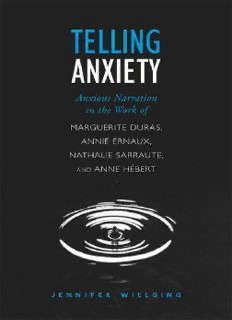
Telling Anxiety: Anxious Narration in the Work of Marguerite Duras, Annie Ernaux, Nathalie Sarraute, and Anne Hébert PDF
Preview Telling Anxiety: Anxious Narration in the Work of Marguerite Duras, Annie Ernaux, Nathalie Sarraute, and Anne Hébert
TELLING ANXIETY: ANXIOUS NARRATION IN THE WORK OF MARGUERITE DURAS, ANNIE ERNAUX, NATHALIE SARRAUTE, AND ANNE HÉBERT This page intentionally left blank JENNIFER WILLGING Telling Anxiety Anxious Narration in the Work of Marguerite Duras, Annie Ernaux, Nathalie Sarraute, and Anne Hébert UNIVERSITY OF TORONTO PRESS Toronto Buffalo London www.utppublishing.com © University of Toronto Press Incorporated 2007 Toronto Buffalo London Printed in Canada ISBN 978-0-8020-9276-2 Printed on acid-free paper Library and Archives Canada Cataloguing in Publication Willging, Jennifer Telling anxiety : anxious narration in the work of Marguerite Duras, Annie Ernaux, Nathalie Sarraute, and Anne Hébert / Jennifer Willging. (University of Toronto romance series) Includes bibliographical references and index. ISBN 978-0-8020-9276-2 1. Duras, Marguerite – Criticism and interpretation. 2. Ernaux, Annie, 1940– – Criticism and interpretation. 3. Sarraute, Nathalie – Criticism and interpretation. 4. Hébert, Anne, 1916–2000 – Criticism and interpretation. 5. Narration (Rhetoric) – History – 20th century. 6. Anxiety in literature. I. Title. II. Series. PQ673.W54 2007 843.00923 C2007-900814-3 University of Toronto Press acknowledges the financial assistance to its publishing program of the Canada Council for the Arts and the Ontario Arts Council. Contents Acknowledgments vii Introduction: Narrative Anxiety, Narrative Desire 3 PART ONE: NARRATING THE SELF, NARRATING THE OTHER 1 ‘Truth’ in Memory and Narrative: Marguerite Duras’s ‘Monsieur X. dit ici Pierre Rabier’ 27 2 Shame in Memory and Narrative: Annie Ernaux’s La honte 73 PART TWO: NARRATING LIFE, NARRATING DEATH 3 The Anxiety of Influence and the Urge to Originate: Nathalie Sarraute’s Entre la vie et la mort 117 4 The Sound of the Semiotic: Anne Hébert’s Les fous de Bassan 154 Conclusion 188 Notes 197 Bibliography 239 Index 251 This page intentionally left blank Acknowledgments I wish to thank the College of Humanities and the Department of French and Italian at the Ohio State University for their generous support of my research. They have provided me with the leaves from teaching and the funding necessary to complete this book. I thank Diane Birckbichler and Debra Moddelmog in particular for going above and beyond their duties to help me bring this project to fruition. I am also indebted to Judith Mayne, who has been a wise and inspirational mentor to me over the past six years. Her multiple readings of the manuscript throughout its evolu- tion have unquestionably strengthened the final product (although I take exclusive responsibility for its shortcomings). Mary Jean Green’s excellent suggestions for revision, and her enthusiasm, have also been of invaluable aid to me. I thank Karlis Racevskis and Eugene Holland for their help with various sections of the manuscript, as well as for their warm collegiality. Two crucial mentors and readers of the earliest versions of the manuscript were Mireille Rosello and Gerald Mead. I am grateful to them for their expertise, kindness, and steadfast encouragement. At the University of Toronto Press, several anonymous readers contrib- uted to the improvement of the manuscript, and I thank them, however impersonally. Matthew Kudelka has been a talented and meticulous copy editor, leaving not a single American spelling or misused relative pro- noun unaltered. Most importantly, I extend my sincere appreciation to Jill McConkey, my editor. Her guidance, praise, and constant good cheer have brightened my days throughout this process. On a more personal note, I owe a debt of gratitude to my father, Ronald Willging, for his scrupulous and unpaid editing, and to both him and my mother, Joy Willging, for their confidence in me and for their love. I am very lucky to be their daughter. Finally, I wish to express my viii Acknowledgments deepest gratitude to my husband and my own personal coach, Andrew Teitelbaum, whose ‘tough love’ during the writing of this rather autobio- graphical book on anxiety made its completion possible. I am so glad I was wrong. Earlier versions of sections of chapters 1 and 2 have been published as ‘“True Down to the Last Detail”: Narrative and Memory in Marguerite Duras’s “Monsieur X.”’ in Twentieth Century Literature 46 (2001): 369–86; and ‘Annie Ernaux’s Shameful Narration’ in French Forum 26 (2001): 83– 103. I thank the editors of these journals for allowing me to reprint mate- rial from these articles. TELLING ANXIETY: ANXIOUS NARRATION IN THE WORK OF MARGUERITE DURAS, ANNIE ERNAUX, NATHALIE SARRAUTE, AND ANNE HÉBERT
Description: